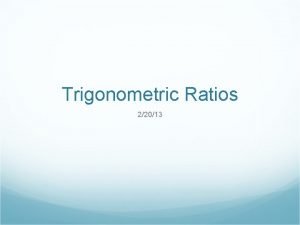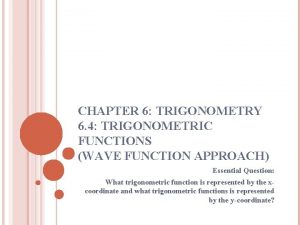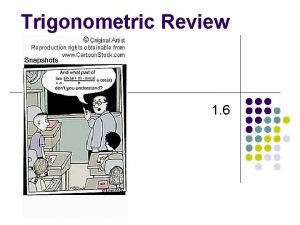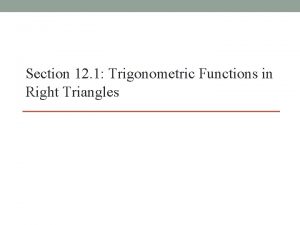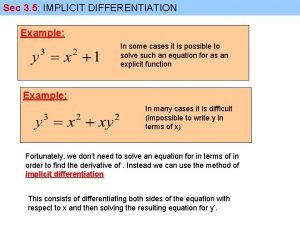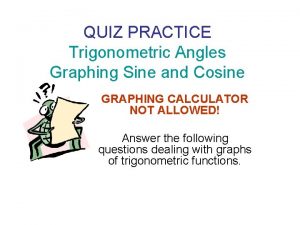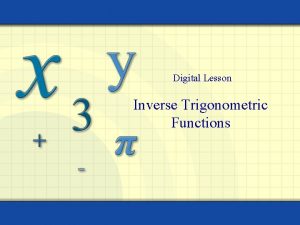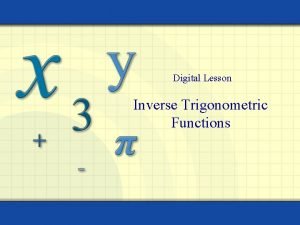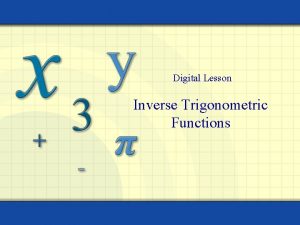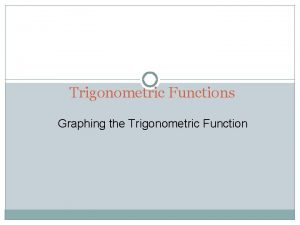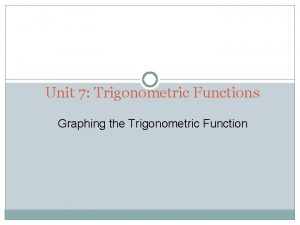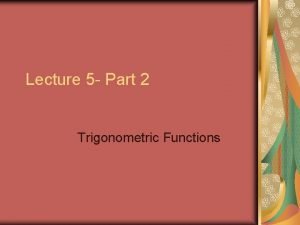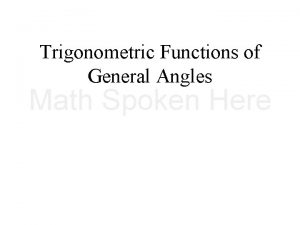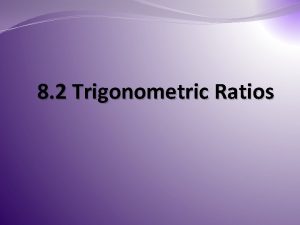Chapter 7 Trigonometric Functions The sine Function Imagine


















- Slides: 18

Chapter 7: Trigonometric Functions

The sine Function Imagine a particle on the unit circle, starting at (1, 0) and rotating counterclockwise around the origin. Every position of the particle corresponds with an angle, θ, where y = sin θ. As the particle moves through the four quadrants, we get four pieces of the sin graph: I. From 0° to 90° the y-coordinate increases from 0 to 1 II. From 90° to 180° the y-coordinate decreases from 1 to 0 III. From 180° to 270° the y-coordinate decreases from 0 to − 1 IV. From 270° to 360° the y-coordinate increases from − 1 to 0 sin θ 90° 135° 45° I 0° 180° 0 II 90° 180° III 225° 315° 270° Interactive Sine Unwrap 360° θ 270° IV θ sin θ 0 0 π/2 1 π 0 3π/2 − 1 2π 0

Sine is a periodic function: p = 2π sin θ − 3π − 2π −π 0 π 2π One period 2π sin θ: Domain (angle measures): all real numbers, (−∞, ∞) Range (ratio of sides): − 1 to 1, inclusive [− 1, 1] sin θ is an odd function; it is symmetric wrt the origin. sin(−θ) = −sin(θ) 3π θ

The cosine function Imagine a particle on the unit circle, starting at (1, 0) and rotating counterclockwise around the origin. Every position of the particle corresponds with an angle, θ, where x = cos θ. As the particle moves through the four quadrants, we get four pieces of the cos graph: I. From 0° to 90° the x-coordinate decreases from 1 to 0 II. From 90° to 180° the x-coordinate decreases from 0 to − 1 III. From 180° to 270° the x-coordinate increases from − 1 to 0 IV. From 270° to 360° the x-coordinate increases from 0 to 1 cos θ 90° 135° 45° I 0° 180° 0 IV 90° II 225° 315° 270° 180° III θ 360° θ cos θ 0 1 π/2 0 π − 1 3π/2 0 2π 1

Cosine is a periodic function: p = 2π cos θ θ − 3π − 2π −π 0 π One period 2π cos θ: Domain (angle measures): all real numbers, (−∞, ∞) Range (ratio of sides): − 1 to 1, inclusive [− 1, 1] cos θ is an even function; it is symmetric wrt the y-axis. cos(−θ) = cos(θ) 2π 3π

Tangent Function Recall that . Since cos θ is in the denominator, when cos θ = 0, tan θ is undefined. This occurs @ π intervals, offset by π/2: { … −π/2, 3π/2, 5π/2, … } Let’s create an x/y table from θ = −π/2 to θ = π/2 (one π interval), with 5 input angle values. θ sin θ cos θ tan θ −π/2 − 1 0 −∞ −π/2 −∞ − 1 −π/4 − 1 0 0 0 1 π/4 1 ∞ π/2 ∞ −π/4 0 0 1 π/4 π/2 1 0

Graph of Tangent Function θ tan θ −π/2 −∞ −π/4 − 1 0 0 π/4 1 π/2 ∞ tan θ − 3π/2 −π/2 0 π/2 One period: π tan θ: Domain (angle measures): θ ≠ π/2 + πn Range (ratio of sides): all real numbers (−∞, ∞) tan θ is an odd function; it is symmetric wrt the origin. tan(−θ) = −tan(θ) Vertical asymptotes where cos θ = 0 3π/2 θ

Cotangent Function Recall that . Since sin θ is in the denominator, when sin θ = 0, cot θ is undefined. This occurs @ π intervals, starting at 0: { … −π, 0, π, 2π, … } Let’s create an x/y table from θ = 0 to θ = π (one π interval), with 5 input angle values. θ 0 sin θ 0 cos θ cot θ 1 ∞ 0 ∞ 1 π/4 1 0 π/2 0 − 1 3π/4 − 1 −∞ π/4 π/2 1 0 3π/4 π 0 – 1

Graph of Cotangent Function: Periodic Vertical asymptotes where sin θ = 0 cot θ θ cot θ 0 ∞ π/4 1 π/2 0 3π/4 − 1 π −∞ − 3π/2 -π −π/2 cot θ: Domain (angle measures): θ ≠ πn Range (ratio of sides): all real numbers (−∞, ∞) cot θ is an odd function; it is symmetric wrt the origin. tan(−θ) = −tan(θ) π 3π/2

Graph of the Tangent Function To graph y = tan(x), use the identity . At values of x for which cos(x) = 0, the tangent function is undefined and its graph has vertical asymptotes. y Properties of y = tan(x) 1. domain : all real x 2. range: (– , + ) x 3. period: 4. vertical asymptotes: period: 10 Copyright © by Houghton Mifflin Company, Inc. All rights reserved.

Example: Find the period and asymptotes and sketch the graph of y 1. Period of y = tan x is pi. x 2. Find consecutive vertical asymptotes by solving for x: Vertical asymptotes: 3. Plot several points in 4. Sketch one branch and repeat. 11 Copyright © by Houghton Mifflin Company, Inc. All rights reserved.

Time to Practice!! Let's Go

Cosecant is the reciprocal of sine csc θ − 3π Vertical asymptotes where sin θ = 0 θ 0 − 2π −π π 2π 3π sin θ One period: 2π sin θ: Domain: (−∞, ∞) csc θ: Domain: θ ≠ πn Range: [− 1, 1] (where sin θ = 0) Range: |csc θ| ≥ 1 or (−∞, − 1] U [1, ∞] sin θ and csc θ are odd (symm wrt origin)

Secant is the reciprocal of cosine Vertical asymptotes where cos θ = 0 sec θ − 3π − 2π −π 0 π 2π θ 3π cos θ One period: 2π cos θ: Domain: (−∞, ∞) sec θ: Domain: θ ≠ π/2 + πn Range: [− 1, 1] (where cos θ = 0) Range: |sec θ | ≥ 1 or (−∞, − 1] U [1, ∞] cos θ and sec θ are even (symm wrt y-axis)

Summary of Graph Characteristics Def’n ∆ о sin θ csc θ cos θ sec θ tan θ cot θ Period Domain Range Even/Odd

Summary of Graph Characteristics Def’n ∆ о Period Domain Range Even/Odd − 1 ≤ x ≤ 1 or [− 1, 1] odd sin θ opp hyp y r 2π (−∞, ∞) csc θ 1. sinθ r. y 2π θ ≠ πn cos θ adj hyp x r 2π (−∞, ∞) sec θ 1. sinθ r y 2π θ ≠ π2 +πn tan θ sinθ cosθ y x π θ ≠ π2 +πn All Reals or (−∞, ∞) odd cot θ cosθ. sinθ x y π θ ≠ πn All Reals or (−∞, ∞) odd |csc θ| ≥ 1 or (−∞, − 1] U [1, ∞) All Reals or (−∞, ∞) |sec θ| ≥ 1 or (−∞, − 1] U [1, ∞) odd even

Graphing Trig Functions on the TI 89 Mode critical – radian vs. degree Graphing: Zoom. Trig sets x-coordinates as multiple of π/2 Use Zoom. Trig. Enter the function. This is the graph. Graph the following in radian mode: sin(x), cos x [use trace to observe x/y values] Switch to degree mode and re-graph the above What do you think would happen if you graphed –cos(x), or 3 cos(x) + 2? [We’ll study these transformations in the next chapter]

Special Thanks To: Holmdel, NJ Public schools www. holmdel. k 12. nj. us/. . . /L 7. 4%20 and%207.
 Imagine and explore
Imagine and explore What is a trigonometric ratio
What is a trigonometric ratio Nullum crimen nulla poena sine lege
Nullum crimen nulla poena sine lege Nullum crimen sine lege nulla poena sine lege
Nullum crimen sine lege nulla poena sine lege Injuria sine damno and damnum sine injuria difference
Injuria sine damno and damnum sine injuria difference Chapter 6 trigonometric functions
Chapter 6 trigonometric functions Chapter 4 trigonometric functions
Chapter 4 trigonometric functions Chapter 6 trigonometry
Chapter 6 trigonometry Chapter 5 trigonometric functions
Chapter 5 trigonometric functions Chapter 4 trigonometric functions
Chapter 4 trigonometric functions Chapter 13 trigonometric functions answers
Chapter 13 trigonometric functions answers Trigonometry cofunction
Trigonometry cofunction Three basic trigonometric functions
Three basic trigonometric functions Transformation of trigonometric functions
Transformation of trigonometric functions How to find period from sine graph
How to find period from sine graph 12-7 graphing trigonometric functions answers
12-7 graphing trigonometric functions answers 12-1 trigonometric functions in right triangles
12-1 trigonometric functions in right triangles Differentiate trigonometric
Differentiate trigonometric Graphing sine and cosine functions quiz
Graphing sine and cosine functions quiz

